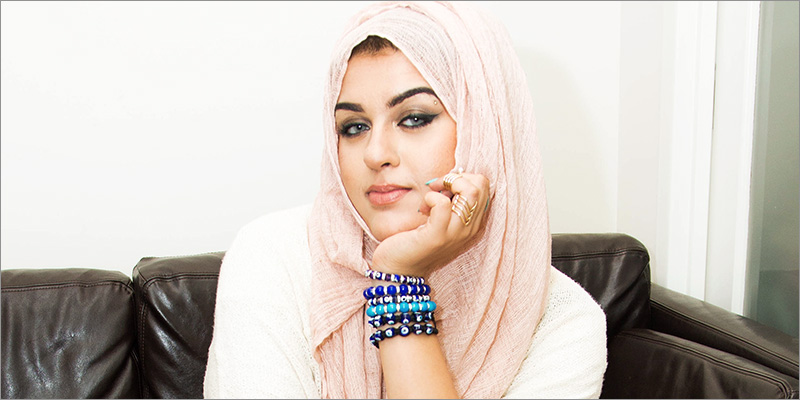*This post of mine is published on Forbes Woman.*
Employing their own spin on the popular “100 Years of Beauty” online videos, MuslimGirl.com just launched a new series, “100 Years of Hijab Fashion in 1 Minute,” to dismiss common misconceptions and stereotypes about the hijab, and more importantly, the women who wear it. MuslimGirl’s founder, and Forbes 30 Under 30 honoree, Amani Al-Khatahtbeh, says the fashion industry’s recent embrace of the clothing dismisses the social and political history of the hijab.
“We want to reinsert nuance into the hype surrounding the hijab and modest fashion right now,” Al-Khatahtbeh tells me. “Everyone is quick to drop trending hashtags and blog headlines about how cool our headscarves are, but its connection to the identities and history of Muslim women is totally left out of the conversation.”
What is that’s being left out exactly? According to MuslimGirl.com’s website:

“…For generations, [the hijab] has been a powerful symbol of Muslim women’s defiance against the male gaze, colonialism, and Islamophobia as we know it today. It’s also become a politicized garment that represents Muslim women’s control and autonomy, and has been at the center of a tug-of-war between governments and the people for its reclamation.
With major international design houses, most recently Dolce & Gabbana, (with its line of bejeweled hijabs), gearing up to cash in on the world of Muslim women’s fashion, the video launch could not be better timed. The first installment of the series focuses on the political role of the hijab in social movements across the Middle East, North Africa and Asia, demonstrates that despite their often passive portrayal in the media, Muslim women have always been active in their countries.
“MuslimGirl’s tagline is “Muslim women talk back,” Al-Khatahtbeh explains. “I would like to think of this video as our response to the commodification and regulation of hijab. Corporate media only talks about headscarves in terms of fashion trends or political ideology. Our society only finds hijab acceptable when it conforms to Western trends, yet turns a blind eye when Muslim women are targeted for wearing it in today’s heightened Islamophobia. While corporations are quick to profit off of it and some governments impose laws that either restrict or enforce it, we are making a proud statement of our own autonomy and empowerment.”

Making sure Muslim women are seen and heard has been at the core of Al-Khatahtbeh’s personal mission since 2009 when she first started MuslimGirl as “a hobby that turned into a social movement” by creating an online platform for Muslim women’s voices, and publishing stories on topics such as coping with your period as a Muslim woman, gay imams and racism in the Muslim community.
The video, which is the first in a series MuslimGirl plans to release, spans from 1910 to 2010 and shows how Muslim women from Pakistan to Algeria to Iraq have worn the hijab as a sign of resistance throughout history.
How the MuslimGirl team went about selecting the countries represented in the first video was carefully thought out, especially showing how the hijab’s significance played out in societies such as Afghanistan and Iraq in the aftermath of the U.S. invasion.

“We wanted to include a selection of countries that really represents our limited understanding of the Muslim world — and, by extension, the Muslim people — and has been the greatest recipient of failed foreign policy and military intervention in the past century,” Al-Khatahtbeh states. “We also wanted to include countries and time periods in which governments have imposed or restricted the hijab, because they are integral to the political evolution of the hijab as it relates to Muslim women’s autonomy and control throughout the ages.”
The power of a video made by Muslim women about what the hijab means to them is in itself quite a revolutionary act in itself, and viewers are definitely noticing. In not even two weeks since its release, the video has already been garnered almost a million views.
Al-Khatahtbeh tells me that increasing the visibility of Muslim women in a digitally connected world is crucial, and that her ultimate goal is to make history by becoming the first mainstream media network by and for Muslim women.

“My favorite part of the video now is the middle finger raised for Iraq, because of the powerful reaction it’s created,” Al-Khatahtbeh says. “A lot of viewers felt very strongly about seeing a veiled Muslim woman make an insulting gesture. I think it’s an amazing opportunity for us to reflect and have valuable discourse about that double standard, and what modesty means as applied to Muslim women, especially in terms of our expression of political anger.”
Al-Khatahtbeh goes on to say that the hijab’s evolution is still ongoing, and even in today’s world of heightened Islamaphobia, the hijab remains a symbol of defiance. “In moments of extreme oppression throughout history, we often see marginalized communities experience a huge swing towards reasserting their identities,” Al-Khatahtbeh says, pointing out that despite the current rise of anti-Muslim rhetoric and sentiment, the hijab remains more a political statement than a fashionable one.
Make sure to follow the video series and watch out for its newest installments on MuslimGirl.com.
*This post of mine is published on Forbes Woman.*
